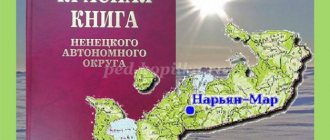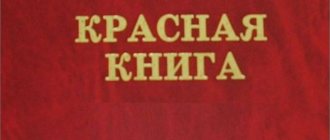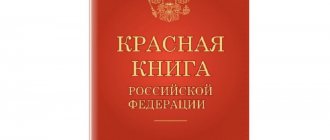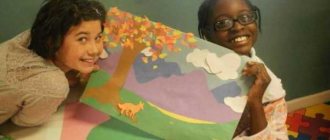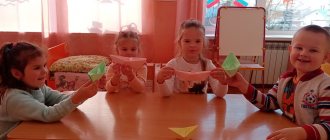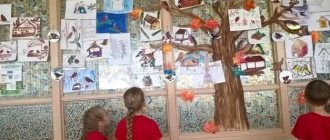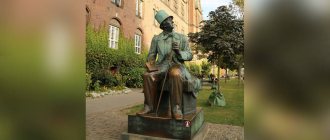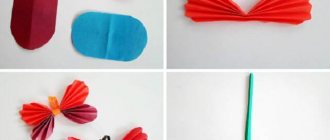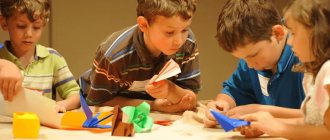Environmental project: “Red Book of Russia”
Project Information Card
Topic: “Animals and plants of the Red Book of Russia.”
Authors and project leaders : Lavrova E.M., (teacher at the Children's Preschool Educational Institution, kindergarten No. 1, Orekhovo-Zuyevo).
Project participants: children of the preparatory school group “Bell” (from 6 to 7 years old), parents, teachers of the group.
Project type: medium duration (7 weeks).
Project type: practice-oriented, group, educational, research, creative.
Integration with educational areas: “Socio-communicative development”, “Cognitive development”, “Speech development”, “Artistic and aesthetic development”, “Physical development”.
Problem: insufficient level of children's knowledge about the Red Book and the animals listed in it.
Relevance: in modern conditions, when the scope of educational influence is significantly expanding, the problem of environmental education of preschool children acquires special significance and relevance. It is necessary to instill in children a caring attitude towards animals and a desire to protect them. Hypothesis: The Red Book is necessary as a source of information about environmental problems. Animals and plants cannot do without human help. Will humans be able to prevent the extinction of rare, endangered species of plants and animals? Goal: to draw children's attention to the problem of the disappearance of some animals in Russia. Introduce children to the Red Book. Show where and how animals exist. Give children basic ideas about how a person can help animals. The fact that people, having little knowledge of nature, have killed many animals. To form an ecological culture among preschoolers and encourage them to be active defenders of nature. Teach children to work with additional materials.
Tasks:
- To form children’s primary ideas about the Red Book.
- To form children’s knowledge about rare and endangered species of animals in Russia and about the measures necessary for their conservation based on material accessible to their understanding, to replenish and activate their vocabulary.
- To develop children’s search activity, cognitive-speech activity, coherent speech, and curiosity. Teach children to pass on the knowledge acquired during search activities to their comrades by writing stories about animals and interesting facts from their lives.
- Help children remember the rules of behavior in nature.
- Develop the ability to generalize and draw conclusions.
- Expand children's knowledge about nature reserves and funds to support the survival of rare animal species in our country.
- To cultivate a kind, merciful, responsible, caring attitude towards nature and its inhabitants, a sense of kindness and compassion for all living things.
- Develop children's creative abilities, imagination, aesthetic taste through artistic creativity.
- Involve parents in joint activities with children.
Expected results of the project:
- Improving the quality of the educational process.
- Children have an idea about the “Red Book”.
- Children expanded and enriched their knowledge about the life of animals listed in the Red Book of Russia.
- The children have developed the foundations of environmental education and have a desire to learn even more about the endangered species of plants and animals of our region.
- Children show interest and respect for the environment and have become more careful about the nature of their region.
- Development of critical and creative thinking in children.
- An effective “triple alliance” - teacher-parent-child.
- A sense of ownership and satisfaction from the child’s success.
- Increasing the competence of teachers and enriching teaching experience.
Project implementation forms:
- equipping the subject-spatial environment;
- classes;
- conversations;
- working with parents;
- gaming technologies;
- creative activity;
- project presentation.
Project implementation stages
Stage I. Organizational (preparatory): Study and selection of program and methodological material in the field of work.
Ascertaining diagnostic study on environmental education of preschool children and a survey of parents.
Improving the development environment, creating files of games, experiences and experiments.
Update and addition in the reading corner of educational and artistic literature: these are children's encyclopedias, magazines about wild animals, illustrations, mini-games, puzzles, educational games: “Zoological Lotto”, “Find a Pair”, “Homeland of Animals”, “Animals”, “Good friends”, etc.
Immersion in the problem: showing the presentation “The Main Book of Nature”.
Goal: acquaintance with the Red Book as a state document and its significance.
Coloring pages “Animal from the Red Book of Russia”.
Drawing according to the theme: “My favorite animal.”
Presentation of information in the parent corner on the topics: “Environmental education of preschool children”, “Earth Day”.
Conversations with parents about the need to visit the zoo, nature reserves, etc.
Stage II. Practical “We are explorers”
Conducting discussions on the topics: “Creation of the Red Book”, “Through the pages of the Red Book - rare animals and plants”, “Reserves of Russia”, “Zoo”.
Conducting direct educational activities on the project topic:
- “What is the Red Book for?”
- “What is a reserve?”
— “Journey to Planet Earth”
— Modeling on the themes: “We love nature”, “Animal from the Red Book”.
Game activity:
- Didactic games “Reminder signs”, “Find your animal”.
- Role-playing games: “We are at the zoo”, “Photo hunt in the forest”.
- Game-task “Pick up the beak.”
- Ecological game "Thanksgiving".
- Outdoor games “What kind of animal am I?”, “Sly fox”, “Flies, swims, runs”, “Air, earth, water”.
Reading fiction: B. Zakhoder “What Happened to the River”; fairy tale by V. Bianki “Owl”, E. Charushin “Hare”, “Fox”, “Wolf”, poem by P. Voronko “Lipka”, K. Balmont “For Mushrooms”, Y. Akim “Earth”.
Listening to songs “The Earth is our common home” music by N. B. Karavaeva; “Multi-Colored Planet” music by A. Orlov; “The Red Book” music by O. Gazmanov.
Observations and research activities while walking.
Children and their parents prepare a short report about an animal from the Red Book of Russia as part of the project.
Visiting children with their parents to the petting zoo in Orekhovo-Zuevo.
Participation in the following campaigns: “Bring a book about nature”, “Take care of nature” (studying the rules of behavior in nature in order to preserve its wealth; creating environmental signs).
Artistic and productive activity: creating Red Book animals using non-traditional artistic techniques.
Creation of the Red Book of the Animals of Russia group.
Stage III. Final (project result)
Working with parents.
Project implementation
Stage I. Organizational (preparatory).
Organization of successful work on environmental education of children
is impossible without determining the initial level of environmental ideas in older preschoolers.
The work methodology we developed included the following conditions for its implementation:
– diagnostics were carried out in natural conditions with comparative
homogeneity of the composition of children in groups;
– the research was conducted on material whose content
corresponds to the objectives of the educational process in preschool educational institutions;
– in the group, diagnostic classes were conducted by one teacher.
Parents of older preschoolers were offered the questionnaire “Environmental education of children” to identify the parents’ attitude to the relevance of the topic of ecology, environmental problems, environmental protection, rational use of natural resources, and environmental education of children of older preschool age. As a result, it turned out that the majority of parents know what ecology is and what it does, they love animals, birds, have plants and animals at home, have a positive attitude towards nature, only 10% of the parents in the group introduce their children to the rules of behavior in nature.
The results obtained showed that almost all parents have a low level of environmental knowledge.
23 preschoolers from the “Bells” group took part in the primary sample.
The main goal of this stage of work was to determine the initial level of ecological ideas about the patterns and interrelations of natural phenomena, the unity of living and inanimate nature, the interaction and interdependence of nature, society and man among older preschoolers.
We determined the level of development of environmental concepts in children of senior preschool age using a number of tasks that were carried out individually with each child:
Task 1. “Determination of the characteristic features of representatives of the animal world,” the main goal of which is to determine the level of knowledge of the characteristic features of representatives of the animal world.
Task 2. “Determination of the characteristic features of the plant world,” the purpose of which is to determine the level of knowledge of the characteristic features of the plant world.
Task 3. “Determination of the characteristic features of inanimate nature,” the main goal of which is to determine the level of knowledge of the characteristic features of inanimate nature.
Task 4. “Knowledge of the seasons”, the purpose of which is to determine the level of knowledge of the seasons.
Task 5. “Ecological attitude towards the natural world”, the purpose of which is to determine the level of environmentally correct attitude towards the natural world.
We have identified 3 levels of environmental ideas among preschoolers (see Table 1)
Table 1.
Levels of ecological ideas in older preschoolers
| № | Level name | Characteristic |
| 1 | High | The child easily distributes representatives of the flora and fauna by species, gives reasons for his choice, correlates representatives of flora and fauna with their habitat, knows the characteristic features of plants and animals, answers questions posed coherently and consistently without much difficulty, shows interest in plants and animals, emotionally expresses his attitude towards indoor plants, animals, birds and insects, without the help of an adult, names the conditions necessary for the life, growth and development of indoor plants, domestic animals, tells how to properly care for them, correctly names the distinctive characteristics of objects of inanimate nature , when answering the questions posed, he shows creativity and imagination, reproduces from memory the seasonal features of a particular time of year, expresses an aesthetic attitude towards nature, understands the relationship between human activity and the life of animals, birds and plants, and easily expresses his attitude to the problem. |
| 2 | Average | The child sometimes makes minor mistakes when distributing representatives of the animal and plant world by species, does not always give reasons for his choice, mainly correlates representatives of flora and fauna with their habitat, knows the characteristic features, but sometimes makes inaccuracies in the answers, answers the questions posed consistently, but sometimes the answers are too short, shows interest and emotionally expresses his attitude towards indoor plants, animals, birds and insects, without the help of an adult, names the conditions necessary for the life, growth and development of indoor plants and pets, practical skills and skills in caring for indoor plants are not sufficiently formed, names the main distinctive characteristics of objects of inanimate nature, after additional questions from an adult, gives examples of how people use objects of inanimate nature, correctly names the seasons, sometimes finds it difficult to name them in the right sequence, basically knows the characteristic features of each season, but sometimes makes minor mistakes, does not always understand the relationship between human activity and the life of animals, birds and plants, and can express his attitude to the problem. |
| 3 | Short | The child often makes mistakes when distributing representatives of the animal and plant world by species, does not always give reasons for his choice, does not always correlate representatives of flora and fauna with their habitat, finds it difficult to name characteristic features, finds it difficult to answer questions posed, and if he answers, it is mostly incorrect, does not show interest in indoor plants and does not express his attitude towards animals, birds and insects, finds it difficult to tell how to properly care for indoor plants and pets, in the process of practical activities constantly turns to an adult for help, does not always correctly name the distinctive characteristics objects of inanimate nature, incorrectly names the seasons, finds it difficult to name them in the required sequence, does not know the characteristic features of different seasons, does not express an aesthetic attitude towards nature, does not understand the relationship between human activity and the life of animals, birds and plants, finds it difficult to express his attitude towards problem |
The results of the primary survey showed that almost all older preschoolers have a poor understanding of the patterns and interrelations of natural phenomena, the unity of living and inanimate nature, the interaction and interdependence of nature, society and humans. The work carried out allows us to conclude that environmental education of preschool children is currently incomplete, and environmental activities are a rare phenomenon in the activities of children. The data obtained indicate that it is necessary to change the approach to environmental education of children in preschool educational institutions.
At the preparatory stage, we studied and selected program and methodological material, updated and supplemented the content of the subject-development environment, created a card index of games, experiences and experiments on the topic of ecology.
We diversified the educational and artistic literature corner: children and their parents brought children’s encyclopedias, magazines about wild animals, and illustrations.
We studied and played new mini-games, put together puzzles, played educational games: “Zoological Lotto”, “Find a Pair”, “Homeland of Animals”, “Animals”, “Good Friends”, etc.
We got acquainted with the Red Book through watching the presentation “The Main Book of Nature”, colored the coloring pages “Animal from the Red Book of Russia”, and drew according to the theme: “My favorite animal”.
There was also an information corner for parents on the topic: “Environmental education of preschool children”, “Earth Day”. Conversations were held with parents about the need to visit the zoo.
Stage II. Practical “We are explorers”
| Day of the week | Kind of activity | Program content, goals |
| March | ||
| Monday March 2 | Conversation on the topic: “Journey through the pages of the Red Book.” Observations and research activities while walking | Introduce children to the Red Book, protected plants and animals. Give children an idea of why the book is “red” and introduce them to the contents of the Red Book. |
| Tuesday 3 March | Listening to the song “Red Book” by music. O. Gazmanova. Observations and research activities while walking | Deepening environmental knowledge in children, instilling in them a humane attitude towards nature, a sense of responsibility for all life on Earth. Creating a joyful, spring mood in children. |
| Wednesday 4 March | Complex thematic event “Journey to Planet Earth”. Observations and research activities while walking | Deepen the understanding that planet Earth is a huge ball, most of which is covered with water. Introduce children to the scientific version of the formation of continents on planet Earth, with the symbols of land and water on maps and globes, with the names and location of continents on the map. Bring to an understanding of the uniqueness of our planet, since only on Earth there is life. To foster a desire to protect our Earth. Encourage children to make inferences based on available information. Develop imagination, associative and creative thinking. Improve dialogic and monologue forms of speech. |
| Thursday 5 March | Conversation on the topic: “Animals and plants of the Red Book” Observations and research activities on a walk | Foster a caring attitude towards nature. Introduce rare species of animals and plants. Clarify and activate children's vocabulary. |
| Friday 6 March | Listening to the song “The Earth is our common home” music by N. B. Karavaeva. Observations and research activities while walking | Deepening environmental knowledge in children, instilling in them a humane attitude towards nature, a sense of responsibility for all life on Earth. Creating a joyful, spring mood in children. |
| Tuesday 10 March | Conversation on the topic: “Planet Earth is in danger.” Observations and research activities while walking | To give an idea that planet Earth is a huge ball. Most of the globe is covered with water - oceans and seas. In addition to water, there are continents - solid land - land where people live. There are several such continents: America, Africa, Australia, Europe, Asia, Antarctica. There are two poles on the globe; North and South. |
| Wednesday 11 March | Outdoor game "Air, earth, water, fire." Observations and research activities while walking | Develop reaction and attentiveness, enrich vocabulary. |
| Thursday 12 March | Carrying out the campaign: “Bring a book about nature.” Observations and research activities while walking | Studying the rules of behavior in nature in order to preserve its wealth; creation of a mini-library. |
| Friday 13 March | Direct educational activity “Why is the Red Book needed?” Observations and research activities while walking | To cultivate a kind, merciful, responsible attitude towards nature, towards future descendants who need to leave the Earth to live; to form in children the belief that the beauty of nature is priceless, therefore it must be protected. |
| Monday 16 March | Conversation on the topic: “Zoo”. Observations and research activities while walking | Expand children's knowledge about the inhabitants of the zoo; teach to understand the relationship between the appearance of an animal, its habitat, and feeding habits; consolidate the names of animals in the active dictionary; update knowledge about the professions of zoo employees and their responsibilities. |
| Tuesday 17 March | Children's round table. Observations and research activities while walking | Activate vocabulary on the topic “Animals of the petting zoo”; develop coherent, literate speech; cultivate love and respect for animals. To develop children's creative activity, the ability to create the image of an animal in various ways. |
| Wednesday 18 March | Role-playing game "Zoo". Observations and research activities while walking | Summarize and systematize children’s ideas about animals in our country and other countries; to cultivate a culture of behavior, cognitive interest in natural objects, to develop in children memory, logical thinking, and imagination. Activate the vocabulary (veterinarian, tour guide, poster). |
| Thursday 19 March | Outdoor game “Hunters and Beasts”. Observations and research activities while walking | Strengthen the exercise “throwing at the target”; study of Russian folklore using the example of counting rhymes. Continue to develop motor skills and physical qualities needed in later life, creative imagination; increased activity and overall performance. |
| Friday 20 March | Reading fiction: Y. Akim “Earth”. Observations and research activities while walking | Develop the ability to listen to a piece to the end. Maintain the desire to look at drawings and book designs. Foster a caring attitude towards nature. |
| Monday 23 March | Ecological game: “Reminder signs”. Observations and research activities while walking | Study with children the norms and rules of behavior in nature. Encourage children to be imaginative and creative, and make them want to make whatever contribution they can to environmental education of the population. |
| Tuesday 24 March | Modeling on the theme: “Animal from the Red Book.” Observations and research activities while walking | Teach children to sculpt an animal (from the red book), using techniques: rolling, smoothing, pressing, tightly connecting parts. Continue to learn how to add parts to products (matches), as well as work with a stack (cutting). Develop fine motor skills and imagination. |
| Wednesday 25 March | Role-playing game “An Incident in the Forest.” Observations and research activities while walking | Develop children's ability to interact in games. Using the example of a dangerous situation for the forest and its inhabitants, help children develop the ability to develop the plot of the game. Contribute to the development of game dialogue. Activate children's vocabulary with words: fire hose, fire extinguisher, rescuers, Ministry of Emergency Situations, rescue service, walkie-talkie, dispatcher, veterinarians. To develop children’s ability to play according to their own ideas and to promote the development of creative imagination. |
| Thursday 26 March | Outdoor game “What kind of animal am I?” Observations and research activities while walking | Develop creative attention and imagination; learn to parody and show with gestures. Develop competent, coherent speech, develop descriptive speech skills; teach the ability to negotiate with each other and work in a team. |
| Friday 27 March | Reading fiction: B. Zakhoder “What Happened to the River” Observations and research activities on a walk | Develop the ability to listen to a piece to the end. Maintain the desire to look at drawings and book designs. Foster a caring attitude towards nature. Understand the need for such an attitude towards water as a natural resource |
| Monday 30 March | Direct educational activities: “What is a reserve?” Observations and research activities while walking | Introduce children to the purpose of natural reserves and the Red Book. Strengthen the understanding of the animal and plant world. Foster a caring attitude towards nature. |
| Tuesday 31 March | Reading fiction: the fairy tale “The Owl” by V. Bianchi Observations and research activities during a walk | Develop the ability to listen to a piece to the end. Maintain the desire to look at drawings and book designs. Foster respect for nature |
| Wednesday 1 April | Listening to the song: “Colorful Planet” music by A. Orlov Observations and research activities on a walk | Deepening environmental knowledge in children, instilling in them a humane attitude towards nature, a sense of responsibility for all life on Earth. Creating a joyful, spring mood in children. |
| Thursday 2 April | Reading fiction: E. Charushin “Hare” Observations and research activities on a walk | Develop the ability to listen to a piece to the end. Maintain the desire to look at drawings and book designs. Foster respect for nature |
| Friday 3 April | Outdoor game: “Flies, swims, runs” Observations and research activities during a walk | To form children’s knowledge about the adaptation of the animal world to its environment |
| Monday 6 April | Conversation on the topic: “Reserves of Russia” Observations and research activities on a walk | Form a responsible and caring attitude towards nature; to cultivate a sense of pride that on our native Earth people protect and protect protected areas. |
| Tuesday 7 April | Drawing on the topic: “We love nature” Observations and research activities during a walk | Clarify and expand children's knowledge about environmental safety rules. |
| Wednesday 8 April | Competition of joint creativity of parents and children “Plants and animals from the Red Book of Russia” | Uniting children and teachers, parents in the process of active cooperation. Foster a caring attitude towards nature, diversify knowledge about plant species. |
| Thursday 9 April | Didactic game: “Find a home for the animal” Observations and research activities on a walk | Strengthen children's knowledge about domestic and wild animals |
| Friday 12 April | Outdoor game: “Sly Fox” Observations and research activities during a walk | Develop agility, speed, coordination |
| Monday 13 April | Game-task: “Pick up the beak” Observations and research activities during a walk | Teach imagination and the ability to compare objects |
| Tuesday 14 April | Reading fiction: K. Balmont’s poem “For Mushrooms” Observations and research activities during a walk | Develop the ability to listen to a piece to the end. Maintain the desire to look at drawings and book designs. Foster respect for nature |
| Wednesday 15 April | Carrying out the campaign: “Take care of nature” Observations and research activities during a walk | Studying the rules of behavior in nature in order to preserve its wealth |
| Thursday 16 April | Artistic and productive activity: creating Red Book animals using non-traditional artistic techniques | Unleash the child’s creative potential, constantly increase interest in artistic activities, and develop mental processes. It allows children to feel more relaxed, bolder, more spontaneous, develops imagination, and gives complete freedom for self-expression. |
| Friday 19 April | Visiting children with parents to the petting zoo | Provide an opportunity to observe and directly get to know natural fauna better, strengthen the bond between people and animals |
| Monday 20 April | Discussion of visiting the zoo over the weekend. Creation of the Red Book | |
Stage III. Final (project result)
- Exhibition of drawings “My favorite animal from the Red Book”.
- Creation of a mini-library “Books about nature”.
- Exhibition of environmental signs and drawings “Let's protect nature together.”
- Photo exhibition of family visits to the petting zoo.
- Viewing the presentation “Our Red Book”.
- Control monitoring of environmental education.
- Preparation and holding of the final complex thematic event with the participation of parents “They need our protection.”
Parents of older preschoolers were again offered the questionnaire “Environmental Education of Children” to identify parents’ attitudes to the relevance of the topic of ecology, environmental problems, environmental protection, rational use of natural resources, and environmental education of older preschool children at the end of the project. As a result, it turned out that most of the parents know what ecology is and what it does, they love animals, birds, have plants and animals at home, and have a positive attitude towards nature. The percentage of parents who introduce children to the rules of behavior in nature has increased from the initial level (10%) to 45%.
The results obtained showed that almost all parents' level of environmental knowledge increased from low to average level. The results of the final cross-section showed that the children learned what the Red Book is, the children formed an idea about the flora and fauna of their native land, as well as about nature in different natural zones. The children understood why some animals disappear from the earth and who is to blame. The joint activities of parents and children enriched the communication between them and brought joy.
The project “Acquaintance with the Red Book” was a striking example of the interaction of all participants in the educational process: children, parents, teachers. Partnerships have been established with parents. Work experience presented to colleagues.
Working with parents:
The project involves active interaction with parents. This includes preparing material about selected animals, watching video materials and educational programs about animals on children’s channels with children in their leisure time, selecting and reading environmental literature, participating in promotions and project events, joint excursions with children to the petting zoo, and participating in a diagnostic study. The participation of parents in project activities makes it possible to increase the psychological and pedagogical competence of parents in matters of child-parent relations and the culture of interpersonal interaction between children in the group.
| No. | Forms and methods, methods of work | Target | Responsible |
| 1 | Pedagogical education of Parents Questioning of parents “Environmental education of children” | To direct parents to active joint and pedagogically correct work in the direction of the “Red Book of Plants of Russia”. | Educator: Lavrova E.M.; Salikhanova S.E. |
| 2 | Consultations, reminders: Memo for parents: “Protection of plants”, Memo for parents: “Rules of behavior in nature”, “How to introduce a preschool child to the Red Book” | Introduce parents to the rules of behavior in nature; when in nature, you cannot pick plants for bouquets. Nowadays, the problems of environmental education have come to the fore, and more and more attention is being paid to them. Why did these problems become relevant? The reason is human activity in nature. Illiterate, incorrect from an environmental point of view, wasteful human activity. | Educator: Lavrova E.M.; Salikhanova S.E. |
| 3 | Parent meeting on the topic: “Environmental education in the family” Intellectual and environmental quiz: “Nature experts” | Raising a child is an important task for parents, as a future citizen of our country. At the next stage, tell your child that the Red Book of Russia is collected in two volumes: animals and plants. Show him these books in person or through ICT. | Educator: Lavrova E.M.; Salikhanova S.E. Zabolotnova E.V. Teachers |
| 4 | Competition for joint creativity of parents and children “Plants from the Red Book of Russia” | Uniting children and teachers, parents in the process of active cooperation. | Parents and children of the preparatory group |
| 4 | Block “Interactive interaction with parents.” Project report Multimedia presentation about the project and the presentation “The Red Book of Plants of Russia” made from the joint creativity of teachers and children in the creative living room. | Increase the pedagogical and psychological literacy of parents by expanding the information space. | Educator: Lavrova E.M.; Salikhanova S.E. Zabolotnova E.V. |
Parents of the students expressed a desire to receive consultations on the topic: “What sanctions apply to citizens for disrupting red book plants.”
Parents were unable to choose one most effective method of interaction with teachers during the project. Respondents identified the variability of methods as equally important: memos, consultations, joint creativity competitions, multimedia presentations, a creative living room for parents.
List of used literature:
1. Sample general educational program for preschool education “From birth to school”, edited by N.E. Veraksy, T.S. Komarova, M.A. Vasilyeva – M.: Mozaika-synthesis, 2014.
2. SanPin 2.4.1.3049-13 Sanitary and epidemiological requirements for the structure, content, organization of work in preschool organizations dated May 15, 2013. No26
3. Lopatina A, Skrebtsova M. Environmental education of preschool children - M.: Amrita-Rus, 2008
4. Mayer A.A., Davydova O.I., Voronina N.V. 555 ideas for involving parents in the life of a kindergarten - M.: Sphere shopping center, 2012
5. Maslennikova O.M., A.A. Filippenko Environmental projects in kindergarten - Volgograd, 2009
6. Ryzhova N.A. Me and Nature M.: LINKA-PRESS, 1996
7. Serebryakova T.A. Environmental education in preschool age, textbook for university students - M.: Academy, 2008
8. Gorkova L.G., Kochergina A.V., Obukhova L.A. “Scenarios for classes on environmental education for preschoolers”
9. Molodova L.P. "Ecological holidays for children"
10.Runova M.A., Butilova A.V. "Acquaintance with nature through movement"
11. Nikolaeva S.N., Komarova I.A. “Story games in environmental education”
12. V. Tikhonov » Animals of Russia “Red Book”. year 2009
13. Information and pictures taken from the Internet.
14.https://festival.1september.ru
15. https://tvorcheskie-proekty.ru/node/2231
Ecological family project “Red Book”
Municipal budgetary preschool educational institution
combined kindergarten No. 29 in Yeisk
municipal formation Yeisk district
Ecological family project for preschoolers
"Red Book"
Educator: A.V. Shpak
Explanatory note
- No. 3 Nomination “Red Book”
- Shpak Anna Vladimirovna, school preparatory group
- Shpak Anna Vladimirovna
- "Red Book"
- Study of animals listed in the Red Book
- 2 months
- 8-918-3635769, 353691, Krasnodar region, Yeisk, lane. Pechora, 16/2
Project topic:
"Red Book"
Authors of the project:
Teacher Shpak Anna Vladimirovna
MDOBU kindergarten No. 29 MO Yeisk district, Yeisk, Krasnodar region.
Project type
: research.
Project participants:
children 6-7 years old, teachers, parents.
Project duration
: short-term (2 months).
Purpose (for children) –
find the answer to the question “What animals are listed in the Red Book.” Draw children's attention to the problem of extinction of animals. Introduce children to the Red Book. Show where and how animals exist. Give children basic ideas about how a person can help animals. The fact that people, having little knowledge of nature, have killed many animals. To form an ecological culture among preschoolers and encourage them to be active defenders of nature.
Target (adults)
– create conditions for children to gain knowledge about animals. Preparing material about selected animals, watching videos and educational programs about animals on children's channels, selecting and reading environmental literature, participating in promotions and project events. Participation of parents in project activities allows increasing the psychological and pedagogical competence of parents in matters of parent-child relationships and culture interpersonal interaction of children in a group.
Tasks (for children):
- List the main reasons for the extinction of some animals, name protected ones; explain why wildlife needs to be protected.
- Introduce children to how humans influence nature and for what purpose the Red Book was created, compare the answers received;
- use various sources of information to check the correctness of the answer;
- make a presentation of the project in a group.
Tasks (for adults):
- promote the development of children's cognitive initiative;
- explain in an accessible form “Why the Red Book is needed”, “Which animals are listed in the Red Book”;
- enhance children's knowledge about rare animals.
Foster a love of nature and teach correct behavior in
nature.
Relevance of the project:
In accordance with the Federal State Educational Standard for Additional Education, the priority direction was “Cognitive Development”. The content of the project is based on the principle of integrativeness (social and communicative development, cognitive development, speech development, artistic and aesthetic development).
The creation of the project was prompted by the following motivational questions when looking at a map of the Krasnodar region, photographs of animals, the presentation “Plants and Animals of the Kuban”; in the created communication situation, the teacher asks questions: “Do you know where these animals live and plants grow?”, “What are they known for?” these animals and plants?”, “Where else can you find such animals?”, “Where can you see such plants, what are they for?” and so on. One of the most serious manifestations of the global environmental problem is the rapid decline in the numbers of many species of plants and animals. Some species have already disappeared irrevocably from the face of the Earth, others are on the verge of extinction. The death of animals and plants marked the path of human development.
The relevance of our project was that one of the most serious manifestations of the global environmental problem is the rapid decline in the numbers of many species of plants and animals. Some species have already disappeared irrevocably from the face of the Earth, others are on the verge of extinction. The death of animals and plants marked the path of human development. Harm to nature does not go unnoticed. As a result of the disappearance of plants and animals, acid rain, an increase in the number of toxic landfills, etc., the Earth is increasingly losing its vitality. The main responsibility for this lies with the individual. He is also the main victim of this process. That's why thousands of organizations around the world are trying to improve the living environment.
We determined the goal of the project - to introduce children to the Red Book as a state document and its significance; To form in children environmental knowledge, a caring attitude towards nature and everything around them.
First stage
Creating Motivation
Formulation of the research question
A student in our group brought the encyclopedia “The Red Book of the Krasnodar Territory” to the group, the guys became interested and began to look at it. And the guys had a lot of questions about “What is the Red Book”, “Why exactly these animals are listed in the Red Book”, etc.
Then other children and the teacher are included in the discussion, who help formulate the research question that arose among the preschoolers : “What animals live in the Kuban and are listed in the Red Book.”
Thus, the topic of the educational project was initiated by the preschoolers themselves.
Second phase
Filling out the “Three Questions Model”
Implementation of a project by an enterprising child
In accordance with the Federal State Educational Standard for Education, before starting the project, children were asked to answer three questions (fill out the “Three Question Model”):
| What do we know about rare animals? | What do we want to know? | Where (from whom) can we find out? |
Children's answers:
| Children's answers (We want to know about...):
| Children's answers:
|
After the discussion, the children began searching for information:
Third stage
Started implementing the project (Together with the children and parents, we began collecting books and encyclopedias and designed a mini library “The Red Book of the Krasnodar Territory”
Project presentation
The presentation of the project took place in a group in the presence of a teacher and children of senior preschool age. The teacher placed the pages of her project on a magnetic board and arranged them in the correct sequence. Then she told about the work done, showing relevant illustrations, photographs, and drawings.
After the discussion, the children began searching for information:
- conducted a survey of family members, friends and shared the survey results with peers and kindergarten teachers:
— Darina O.: “My mother and I were looking at the encyclopedia.”
— Emilia: “My mother Marina Nikolaev counts and told me about interesting animals listed in the Red Book
— Plato F. “Mom and I went to the library. There are a lot of books there. From them I learned that there are many beautiful and rare plants in Kuban.”
Fourth stage
Collaborative planning
Implementation of a group project with the aim of enhancing, consolidating and systematizing knowledge about rare animals from the Red Book.
The children in the group became very interested in the project, and then a joint decision was made to implement the group project “The Red Book”. In order to consolidate and systematize the results obtained during the presentation of the project, a joint plan for working on a group project was created. Children, teachers and parents made their suggestions.
| Activity Centers | Events |
| Center for Books and Communication | -Read the story “Friends” by E. Charushin — Read to the children: “Encyclopedia. Wildlife" Rosman, 2014; “Animals of Our Land” Rosman, 2021. (A.V.) — Guessing riddles about animals “1000 riddles” (A.V.) Carry out the “Bring a book about nature” campaign with children. — Play the picture game “Name the Animal” - Talk on the topics: “Acquaintance with the Red Book”, “” (A.V.) — Come up with a fairy tale about a tiger (Darina O.) |
| Science Center | — Watch and discuss with children a presentation about rare animals — Consider the encyclopedia “Red Book” (Darina O.) — Look at pictures of animals and birds (Rostislav Yu.). — Conduct a conversation with the children: “Acquaintance with the Red Book” (A.V.). GCD Ecology “Be a friend to nature.” Form an emotional positive attitude towards the surrounding world and nature. |
| Game center | — Play games:
— Improvisation game “Imagine an animal” “Let's save the wonderful world of plants and animals” (entertainment). — Outdoor nature games: — “Bee and Bears”; — “Fish”; “I am sitting on a stump”; - “Animals gathered at the forest edge”; "Pock". — Didactic games: "Rules of conduct in the forest"; “What sounds do you hear”; “It is possible - it is not possible”; "Don't go astray"; “Who voted”; "Third wheel"; “Who turned into whom”; "Good bad". Plot-role-playing games “We are rescuers”, “Zoo”, “Veterinary hospital”. Through play, instill in children a caring attitude towards all living things. |
| Physical education center | — Play the outdoor game “Sly Fox”, “Hunters and Animals”, “Birds of Migratory” — Conduct a role-playing game “Animal Hospital” — Organize physical education “Journey through the pages of the Red Book...” |
| Art Center | — Make a plasticine sculpture “Animals of our region” — Draw “Animals from the Red Book” (E.D.) — Color the animals in coloring books NOD Modeling “Animals from the reserve”. Strengthen the ability to sculpt from a whole piece, correctly convey the proportions of the body, and give smoothness to the lines. |
| Interaction with parents | — Place the completed “Three Questions Model” and “Joint Plan for the Implementation of the Red Book Project” in the locker room for parents to familiarize themselves with (A.V.) — Place in the corner for parents a list of addresses of Internet sites and children’s literature, where you and your child can find information about rare animals (A.V.) — Involve parents in searching for a video about animals accessible for preschool age (A.V.) — Organize a consultation for parents “Introducing children to the Red Book” (A.V.) — Recommendations for parents “How to teach a child to independently find educational information?” (A.V.) |
All points of the joint plan were implemented
The children were especially interested in the presentation, as well as viewing and reading books: “Children’s Encyclopedia about Rare Animals”, “Amazing Stories”. Preschoolers examined, compared, discussed, and asked adults.
The teacher invited the children to draw drawings of animals and coloring pages.
Fifth stage
Final
The final event of the project was the quiz “What do we know about the Red Book” with the participation of children. Quiz participants demonstrated their knowledge about animals, their lives and habitats in the environment.
We held a competition for the best drawing. The winners were presented with an award.
Next, the teacher and the children analyzed the implementation of the joint plan for working on the project, noting the merits of each, and answering questions.
Questions for children
: - Will you now be able to answer the question “What is the Red Book? How is it listed in the Red Book?” What else have you learned? How and where will you use your knowledge?
Questions for parents: -
What do you think the children learned? What did you learn? Which plan activities were the most successful? What can you do better next time?
The teacher analyzed the results of the project:
| Expected results of the project | Project results obtained |
| 1.Implementation of a joint project will allow: - develop children's cognitive initiative; — preschoolers learn to use various sources of information to check the correctness of the answer. -gain experience in implementing a joint educational project; 2. Participants in the joint project will acquire skills of positive cooperation and interaction. Children have an understanding of the “Red Book”. . | 1. Project participants gained experience in implementing a joint educational project. 2. Project participants demonstrated cooperation skills during joint activities 3.Children learned to use various sources of information to check the correctness of the answer. 4. The developing subject-spatial environment of the group was replenished with game aids and visual material on the topic of the project. 5. Children expanded and enriched their knowledge about the life of animals listed in the “Red Book”. The children have developed the foundations of environmental education and have a desire to learn even more about the endangered species of plants and animals of our region. Children show interest and respect for the environment and have become more careful about the nature of their region. Development of critical and creative thinking in children. An effective “triple alliance” - teacher-parent-child. A sense of ownership and satisfaction from the child’s success. |
